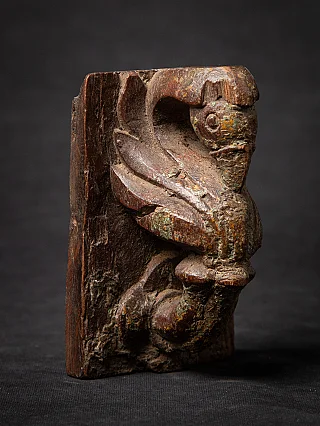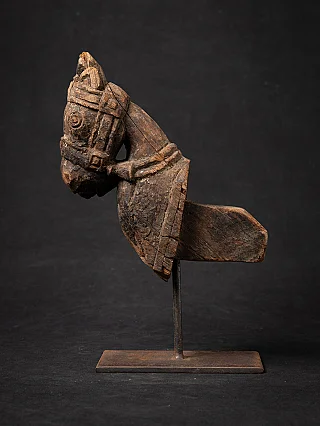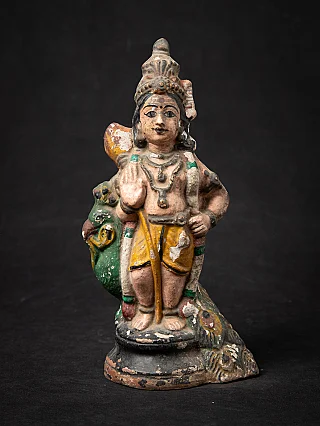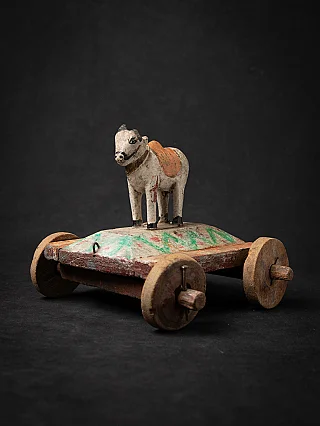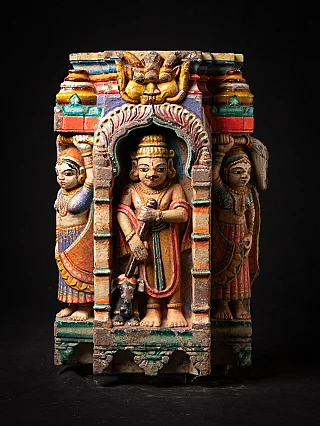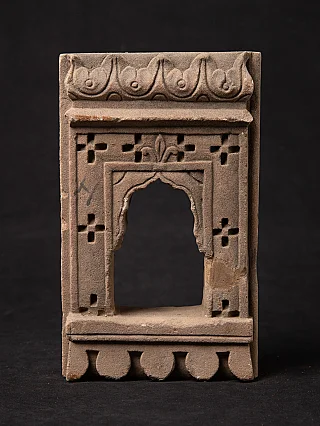Lord Krishna - A Hindu Deity
Author : Peter Vredeveld

Krishna, a hindu deity revered across the expanse of Hinduism, transcends the boundaries of religious worship to become a cultural phenomenon. His divine presence permeates not only the temples and scriptures but also the hearts and minds of millions worldwide.
Origin and Evolution of Krishna Iconography:
Krishna is an incarnation of Vishnu, the supreme being in Hinduism. His iconography finds its genesis in the sacred texts of ancient Hinduism, where he emerges as a multifaceted character in the epic narratives of the Mahabharata and the Bhagavata Purana. The evolution of Krishna's portrayal spans millennia, reflecting the shifting cultural landscapes and philosophical currents of Indian society.
In his earliest depictions, Krishna emerges as a pastoral deity, herding cattle amidst the idyllic landscapes of Vrindavan. His playful dalliances with the milkmaids (gopis) and his exploits as a mischievous cowherd endear him to devotees, portraying him as an accessible and relatable divine figure.
Over time, Krishna's character undergoes a metamorphosis, transcending the confines of his pastoral origins to become a universal symbol of divinity and cosmic harmony. The Bhakti movement, which swept across medieval India, further propelled Krishna into the forefront of religious devotion, emphasizing the path of loving surrender (bhakti) as the most direct means to attain divine grace.
The influences of regional cultures and artistic traditions contributed to the diverse manifestations of Krishna's iconography. In the southern regions of India, particularly in Tamil Nadu and Karnataka, Krishna is worshipped in regal splendor as the supreme deity, adorned with a royal logo and surrounded by celestial attendants. In contrast, the folk traditions of northern India depict Krishna in a more rustic and intimate setting, emphasizing his playful interactions with devotees and the natural world.
Different Names of Krishna:
Krishna, the beloved deity of Hinduism, is known by many names, each reflecting a specific aspect of his divine persona and cosmic role. These names, drawn from ancient scriptures and religious texts, serve as epithets that capture the essence of Krishna's multifaceted nature and universal significance.
- Krishna: The most commonly known name, "Krishna," originates from Sanskrit, meaning "dark" or "black." It symbolizes Krishna's dark blue complexion, which represents the primordial cosmic ocean and signifies his transcendental nature beyond the material world.
- Govinda: This name translates to "the one who gives pleasure to cows." It emphasizes Krishna's pastoral aspect, highlighting his role as a cowherd in the idyllic landscapes of Vrindavan, where he frolicked with the cows and engaged in playful antics with the cowherd boys (gopas).
- Gopala: Derived from the Sanskrit words "go" (cow) and "pala" (protector), "Gopala" signifies Krishna's role as the protector and nurturer of all beings, particularly the cows. It underscores the intimate bond between Krishna and the natural world, emphasizing his compassionate and caring nature.
- Kanha: A popular name among devotees, "Kanha" means "dark" or "attractive." It highlights Krishna's captivating charm and irresistible allure, symbolizing the enchanting beauty that captivates the hearts of devotees and celestial beings.
- Madhava: This name translates to "the consort of the goddess of fortune." It underscores Krishna's association with wealth, prosperity, and abundance, symbolizing his role as the bestower of divine grace and material blessings.
- Nandalal: Meaning "the beloved son of Nanda," Krishna is often called "Nandalal" to emphasize his familial ties with his foster father, Nanda Maharaja. It reflects the intimate bond between Krishna and the residents of Vrindavan, who lovingly raised him as their own.
- Murari: Derived from the Sanskrit words "mura" (demon) and "hari" (destroyer), "Murari" signifies Krishna's role as the vanquisher of demons. It underscores his divine prowess and courage in protecting devotees from evil forces and restoring cosmic order.
- Vasudeva: This name denotes Krishna's lineage as the son of Vasudeva and Devaki. It emphasizes his royal ancestry and divine heritage, underscoring his status as the Supreme Being (Svayam Bhagavan) descended to earth for the welfare of humanity.
- Hari: Translating to "the remover of sins" or "the one who bestows liberation," "Hari" signifies Krishna's role as the redeemer and liberator of souls. It highlights his ability to dispel ignorance, purify hearts, and guide devotees towards spiritual enlightenment.
- Jagannatha: Meaning "the lord of the universe," "Jagannatha" underscores Krishna's cosmic sovereignty and omnipresence. It symbolizes his omnipotent and omniscient nature, transcending all limitations and encompassing creation.
Physical Attributes and Attire of Krishna:

Krishna's physical appearance is imbued with symbolic significance, reflecting his divine nature and cosmic attributes. His appearance can be described as follows:
Dark Blue Complexion: Krishna's dark blue complexion evokes the primordial cosmic ocean, symbolizing infinity and eternity. This hue transcends the limitations of form and color, signifying his divine essence.
Lotus-like Eyes: Krishna's eyes resemble lotus flowers, radiating serenity and inner wisdom. They invite devotees into the depths of spiritual contemplation, reflecting the profound insights and divine knowledge that Krishna embodies.
Peacock Feather Crown: Adorned with a crown adorned with peacock feathers, Krishna embodies beauty, grace, and resilience. The iridescent hues and intricate patterns of the peacock feathers symbolize the vibrant diversity of creation and the eternal dance of life.
Yellow Dhoti: Wrapped in a yellow dhoti, Krishna symbolizes purity and detachment. This attire epitomizes the ideal of renunciation and selflessness, highlighting Krishna's transcendence of the material world in pursuit of spiritual realization.
Sacred Thread (Yajnopavita): The sacred thread adorning Krishna's chest signifies his Brahmanical lineage and spiritual authority. It underscores his role as a divine teacher and guide, imparting timeless wisdom and guiding devotees on the path of righteousness.
Each aspect of Krishna's appearance serves as a visual reminder of his transcendental nature and eternal presence in the hearts of devotees. Together, they form a divine visage that captivates the imagination and inspires devotion across the expanse of Hinduism.
Symbolic Motifs in Krishna Iconography:
Krishna's iconography is rich with symbolic motifs, each carrying profound spiritual significance and figurative meaning:
Flute: Held delicately in Krishna's hands, the flute symbolizes divine music and the universal harmony of existence. Its melodious strains captivate the hearts of all beings, resonating with the eternal rhythm of creation.
Cowherd's Staff (Danda): A ubiquitous attribute in Krishna's portrayal, the cowherd's staff symbolizes his role as a shepherd of souls. It guides them along the path of righteousness and spiritual awakening, reminding devotees of Krishna's compassionate guidance.
Lotus: Often depicted in Krishna's hands or at his feet, the lotus symbolizes purity, enlightenment, and spiritual liberation. It blossoms amidst the murky waters of worldly existence, offering a metaphor for the soul's journey towards divine realization.
Interactions with Animals: Krishna's interactions with animals, particularly the cow and the peacock, serve as poignant allegories of his divine nature and compassionate demeanor. As the protector of all beings, Krishna nurtures a symbiotic relationship with the natural world, embodying the harmony and interconnectedness of all life forms.
These symbolic motifs in Krishna's iconography invite devotees to contemplate the deeper spiritual truths they represent, fostering a profound connection with the divine and guiding seekers on the path of spiritual enlightenment.
Spiritual and Philosophical Significance:
Krishna's iconography serves as a conduit for exploring profound spiritual and philosophical concepts embedded within Hindu cosmology and philosophy. As the Supreme Being (Svayam Bhagavan), Krishna embodies the highest truths of existence, transcending the limitations of time, space, and form.
His divine love (prema) and compassion (karuna) serve as guiding principles for seekers on the path of spiritual realization, inspiring them to cultivate devotion and surrender to the divine will. The Bhagavad Gita, a seminal text within the Hindu tradition, expounds upon Krishna's teachings to Arjuna on the battlefield of Kurukshetra, elucidating the timeless principles of dharma (righteousness), karma (action), and moksha (liberation).
Allegorically, Krishna's iconography unveils the hidden mysteries of the cosmos, revealing the eternal dance of creation and dissolution, the play of light and darkness, and the interplay of divine forces guiding the destinies of all beings. His divine leelas, whether as a playful cowherd or a fearless warrior, serve as symbolic narratives, imparting humanity's timeless wisdom and moral teachings. Through these narratives, devotees are encouraged to reflect upon the deeper truths of existence and strive towards spiritual growth and enlightenment.
Impact on Religious Devotion and Meditation:
The visual representations of Krishna's iconography play a pivotal role in nurturing religious devotion, meditation, and contemplative practices among devotees. Temples dedicated to Krishna serve as sacred sanctuaries where devotees assemble to offer prayers, perform rituals, and immerse themselves in devotional ecstasy.
Meditating upon Krishna's divine form enables seekers to transcend the mundane realities of existence and commune with the divine presence within. His enchanting smile, captivating flute melodies, and graceful gestures are focal points for concentration and inner reflection, leading aspirants toward profound inner peace, enlightenment, and union with the divine.
The transformative power of Krishna's iconography extends beyond the confines of religious worship, permeating every aspect of human consciousness and inspiring seekers to strive for spiritual perfection. Whether through devotional singing (kirtan), sacred storytelling (katha), or meditative contemplation (dhyana), the divine form of Krishna continues to beckon devotees on the eternal quest for truth, love, and divine communion.
In conclusion, Krishna's iconography is not merely a static representation of a mythical figure but a dynamic expression of the eternal truths and timeless principles that govern the universe. Through its intricate symbolism, regional variations, and spiritual depth, Krishna's divine form serves as a beacon of hope and inspiration for seekers of all ages, guiding them toward spiritual awakening and divine realization.
Share this page


















